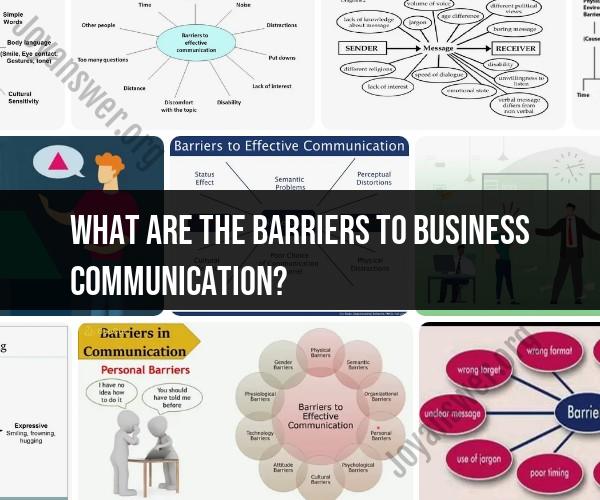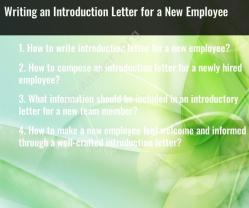What are the barriers to business communication?
Effective business communication is essential for the smooth operation of organizations, but there are several barriers that can hinder communication within a business setting. Identifying and addressing these barriers is crucial for improving communication and enhancing overall organizational performance. Here are some common barriers to effective business communication:
Lack of Clarity and Precision:
- Messages that are unclear, vague, or poorly articulated can lead to misunderstandings and misinterpretations.
Noise and Distractions:
- Physical distractions (e.g., noise in the workplace) and digital distractions (e.g., notifications on devices) can disrupt communication and concentration.
Language Barriers:
- Differences in language and dialect can create challenges, especially in multinational or diverse workplaces.
Cultural Differences:
- Varied cultural norms, customs, and communication styles can lead to misunderstandings and misinterpretations.
Jargon and Technical Language:
- Overuse of industry-specific terminology or jargon can be confusing to those not familiar with it.
Information Overload:
- Excessive information or too many messages can overwhelm employees and make it difficult to focus on critical information.
Emotional Barriers:
- Emotional factors such as fear, anxiety, anger, or stress can hinder effective communication and decision-making.
Lack of Feedback:
- Failing to seek or provide feedback can prevent the identification and resolution of communication issues.
Hierarchical Barriers:
- Hierarchical structures can create power imbalances that discourage open communication, especially from lower-level employees to higher-level management.
Poor Listening Skills:
- Ineffective listening can lead to misunderstandings and hinder the flow of information.
Technology Challenges:
- Technical issues with communication tools and platforms can disrupt virtual communication, such as video conferences and emails.
Physical Barriers:
- Physical separation, such as working in different locations or time zones, can make communication challenging.
Lack of Time:
- Busy schedules and time constraints can limit the opportunity for thorough communication and discussions.
Resistance to Change:
- Employees may resist new communication methods or technologies, making it difficult to implement effective communication strategies.
Crisis Communication Challenges:
- During crises or emergencies, effective communication becomes critical, but challenges such as misinformation and panic can arise.
Generational Differences:
- Different generations may have varying communication preferences and expectations, leading to misunderstandings.
Unwillingness to Share Information:
- Some employees may hoard information or be reluctant to share knowledge due to competition or job security concerns.
To overcome these barriers, organizations can take various measures, such as providing communication training, fostering a culture of open communication, using multiple communication channels, and actively seeking feedback from employees. It's important for businesses to recognize that effective communication is an ongoing process that requires continuous effort and adaptation to changing circumstances.
Breaking Down Barriers: Common Obstacles in Business Communication
Business communication is essential for success in any organization. However, there are a number of common obstacles that can prevent effective communication.
Here are some of the most common obstacles in business communication:
- Language barriers: If you are communicating with someone who speaks a different language, language barriers can make it difficult to understand each other.
- Cultural differences: Cultural differences can also lead to misunderstandings in communication. For example, different cultures have different communication styles, such as direct vs. indirect communication.
- Noise: Noise can be a physical obstacle to communication, such as background noise in a busy office. Noise can also be psychological, such as stress or distractions.
- Lack of attention: If the recipient of your message is not paying attention, they may not understand your message or they may misinterpret it.
- Different communication styles: People have different communication styles. Some people are more direct, while others are more indirect. Some people prefer to communicate in writing, while others prefer to communicate in person. If you are not aware of the recipient's communication style, you may not be communicating effectively.
- Lack of feedback: Feedback is essential for effective communication. It allows you to know if the recipient has received and understood your message. If you do not receive feedback, you may not know if your message has been received or understood correctly.
Effective Communication in Business: Identifying and Overcoming Barriers
The first step to overcoming barriers in business communication is to identify them. Once you have identified the barriers, you can start to develop strategies for overcoming them.
Here are some tips for overcoming common barriers in business communication:
- Language barriers: If you are communicating with someone who speaks a different language, you can use a translation service or hire an interpreter. You can also try to learn some basic phrases in the other person's language.
- Cultural differences: If you are communicating with someone from a different culture, it is important to be aware of their cultural values and customs. You can also try to learn about their communication style.
- Noise: If you are communicating in a noisy environment, try to find a quieter place to talk. You can also use noise-canceling headphones or a microphone to reduce the background noise.
- Lack of attention: If you are trying to communicate with someone who is not paying attention, try to get their attention before you start talking. You can also try to make your message more interesting or engaging.
- Different communication styles: If you are communicating with someone who has a different communication style, try to adapt your communication style to theirs. For example, if the other person is more direct, you should be more direct in your communication.
- Lack of feedback: To ensure that your message has been received and understood correctly, ask the recipient for feedback. You can also ask them to repeat your message back to you.
Bridging the Gap: Strategies for Dealing with Business Communication Challenges
In addition to the tips above, here are some additional strategies for dealing with business communication challenges:
- Be clear and concise: When you are communicating, be clear and concise in your message. Avoid using jargon or technical terms that the recipient may not understand.
- Be an active listener: When someone is talking to you, give them your full attention. Make eye contact, nod your head, and ask clarifying questions.
- Be respectful: Treat the other person with respect, even if you disagree with them. Avoid using disrespectful language or behavior.
- Be open to feedback: If someone tells you that you are not communicating effectively, be open to their feedback. Try to see things from their perspective and make changes to your communication style accordingly.
By following these tips, you can overcome barriers in business communication and improve your communication skills.



